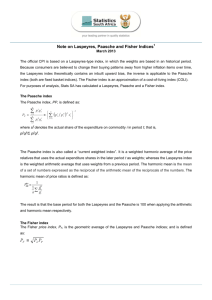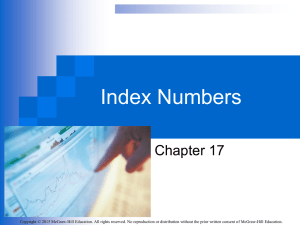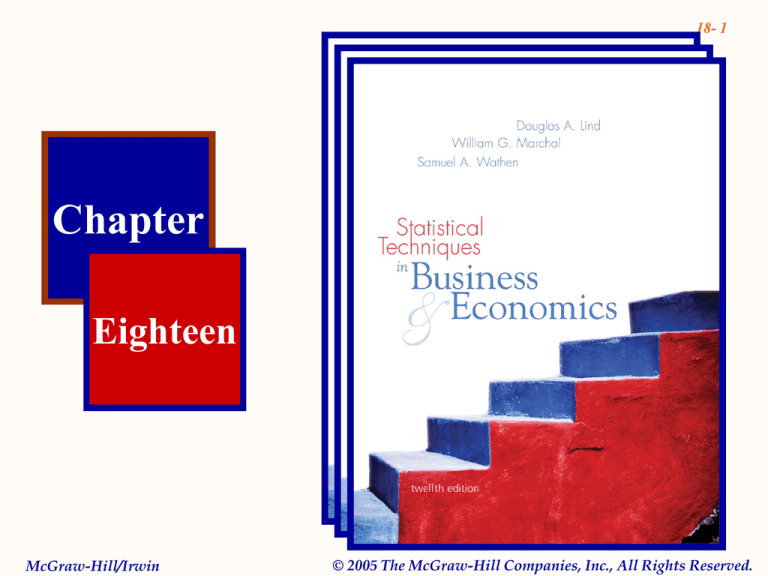
18- 1
Chapter
Eighteen
McGraw-Hill/Irwin
© 2005 The McGraw-Hill Companies, Inc., All Rights Reserved.
18- 2
Chapter Eighteen
Index Numbers
GOALS
When you have completed this chapter, you will be able to:
ONE
Describe the term index.
TWO
Understand the difference between a weighted price index and
an unweighted price index.
THREE
Construct and interpret a Laspeyres Price index.
FOUR
Construct and interpret a Paasche Price index.
Goals
18- 3
Chapter Eighteen continued
Index Numbers
GOALS
When you have completed this chapter, you will be able to:
FIVE
Construct and interpret a Value Index.
SIX
Explain how the Consumer Price index is constructed and
interpreted.
Goals
18- 4
36-Month CPI 2000-2002
4
3
CPI
An Index Number
expresses the relative
change in price,
quantity, or value
compared to a base
period.
2
1
0
1
3
5
7
9
11 13 15 17 19 21
23 25 27 29 31 33
Month beginning 1/1/2002
A Simple Index Number
measures the relative change in
just one variable.
Index Numbers
35
Mr. Wagner
owns stock in
three companies.
Given is the
price per share
at the end of
1997 and 2002
for the three
stocks and the
quantities he
owned in 1997
and 2002.
18- 5
Stock
1997
1997
2002
2002
Price Shares Price Shares
NWS
$1
30
$2
50
NPC
$5
15
$4
30
GAC
$6
40
$6
20
Simple indexes using 1997 as
base year (1997=100)
Price
Share
($2/$1)(100)=200
(50/30)(100)=167
(30/15)(100)=200
($4/$5)(100)=80
(20/40)(100)=50
($6/$6)(100)=100
Example 1
Easier to
Indexes
comprehend
than actual
numbers
$345,651,289,560
(percent
or 10%?
change)
Facilitate
comparison of
unlike series
Bread
Car
Dress
Surgery
18- 6
Why
compute
indexes?
Provide convenient
ways to express the
change in the total
of a heterogeneous
CPI
group of items
$0.89
$18,000
$200
$400,000
Why Convert Data to Indexes?
Indexes: Four classifications
Price
Measures the changes
in prices from a
selected base period
to another period.
18- 7
Quantity
Measures the changes in
quantity consumed from
the base period to
another period.
Special purpose
Combines and weights a
Value
heterogeneous group of series
Measures the change in the to arrive at an overall index
value of one or more items showing the change in
from the base period to the business activity from the
given period (PxQ).
base period to the present.
Types of Index Numbers
18- 8
Price Index
Producer Price Index - measures the
average change in prices received in
the primary markets of the US by
producers of commodities in all
stages of processing (1982=100).
CFMMI
CFMMI Auto
Quantity
Chicago Midwest Manufacturing Index
Base year 1997=100
180
160
140
Federal Reserve
Quantity Output
Index
120
100
80
60
40
20
0
YEAR
1996
1997
1998
1999
2000
2001
2002
Price and Quantity Indexes
18- 9
Jewellery,
watchs and
clocks and
valuable gifts
Department
stores
Furniture
and fixtures
electrical
goods and
photographic
Motor
vehicles and
parts
100
90
80
70
60
50
40
30
20
10
0
Consumer
durable
goods
Value
Index
Value Index of Feb '03 Retail Sales Base February (Monthly Average of
Oct 1999-Sept 2000)=100
Special purpose
Value and Special Purpose Indexes
18- 10
Simple Price Index, P
pt
P
(100)
p0
where
po the base period price
pt the price at the selected
or given period.
From Example 1 a simple
aggregate price index for
the three stocks
p t
P
(100)
p 0
$2 $5 $6
(100)
$1 $5 $6
100.0
Construction of Index Numbers
18- 11
Weighted index
Considers both the price and
the quantities of items
Tends to overweight goods whose prices have increased
Laspeyres Weighted Price Index, P
Two methods of
computing the
price index
Laspeyres method
Paasche method
Uses the base period quantities as
weights
pt q0
P
(100)
p0q0
where
pt is the current price
p0 is the price in the base period
q0 is the quantity consumed in the base
period
Paasche Weighted Price Index, P
Present year weights
substituted for the original
base period weights
18- 12
Tends to overweight
goods whose prices have
gone down
pt qt
P
(100)
p0qt
where
qt is the current quantity consumed
p0 is the price in the base period
pt is the current price.
Construction of Index Numbers
18- 13
Fisher’s Ideal Index
Fisher’s ideal index = (Laspeyres’ index)(Paasche’s index)
The geometric
mean of Laspeyres
and Paasche
indexes
Balances the negative
effects of the
Laspeyres’ and
Paasche’s indices.
Requires that a new set of
quantities be determined
each year.
Fisher’s Ideal Index
18- 14
Value Index
Reflects changes in both price and quantity
Both the price and quantity change
from the base period to the given period
pt qt
V
(100)
p0q0
Value Index
18- 15
In 1978 two
consumer price
indexes were
published. One
was designed for
urban wage
earners and
clerical workers.
It covers about one third of the
population. Another was
designed for all urban
households. It covers about
80% of the population.
Millions of employees
in automobile, steel,
and other industries
have their wages
adjusted upward when
the CPI increases.
Consumer Price Index
18- 16
Usefulness of CPI
It allows consumers to
determine the effect of
price increases on their
purchasing power.
It is a
yardstick for
revising
wages,
pensions,
alimony
payments, etc.
It computes
real income:
real income
= money
income/CPI
(100)
It is an economic
indicator of the
rate of inflation in
the United States.
Consumer Price Index
18- 17
Deflating Sales
Actual sales
Deflated sales
(100)
An approximate index
Determining the purchasing power of the dollar
compared with its value for the base period
$1
Purcha sin g power of dollar
(100)
CPI
Consumer Price Index
17-18
18- 18
Shifting the base
101 115
When two or more series
of index numbers are to be
compared,they may not
101 115
have the same base period.
First select a common base period for all series.
Then use the respective base numbers as the denominators
and convert each series to the new base period.
Consumer Price Index
18- 19
Stock
1997
1997
2002
2002
Price Shares Price Shares
Mr. Wagner
owns stock in
NWS $1
30
$2
50
three companies.
$5
15
$4
30
Shown below is NPC
the price per
GAC $6
40
$6
20
share at the end
of 1997 and
Laspeyres Weighted Price Index, P
2002 for the
p t q 0
P
(100 )
three stocks and
p 0 q 0
the quantities he
$2(30 ) $4(15) $6(40 )
(100 )
owned in 1997
$1(30 ) $5(15 ) $6(40 )
and 2002.
$360
(100 ) 104 .35
$345
18- 20
Paasche Weighted Price Index, P
p t q t
P
(100 )
p 0 q t
$2(50 ) $4(30 ) $6(20 )
(100 )
Value Index
$1(50 ) $5(30 ) $6(20 )
$340
p t q t
(100 ) 106 .25
P
(100 )
$320
p 0 q 0
Fisher’s Ideal Index
F = (104.35)(106.25)
$2(50 ) $4(30 ) $6(20 )
(100 )
$1(30 ) $5(15 ) $6(40 )
$340
(100 ) 98 .55
$345
=105.3
Example 1 continued

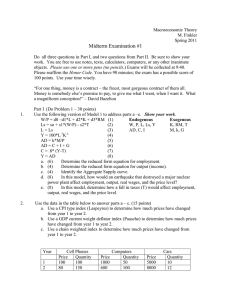
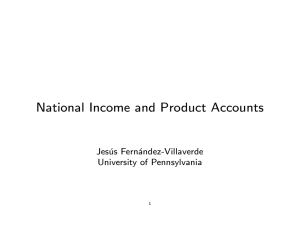
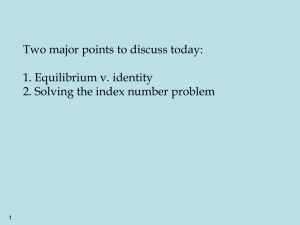
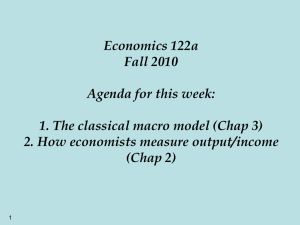
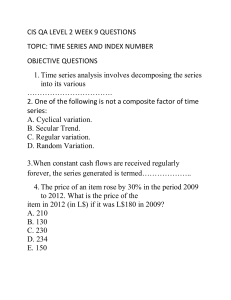

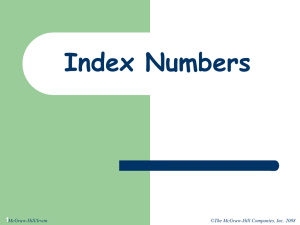
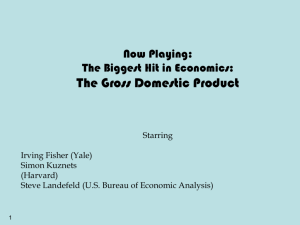
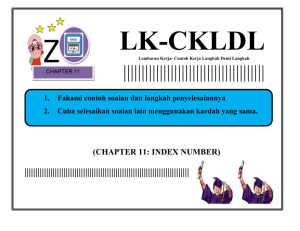
![Methodology Glossary [Tier 2 information ]](http://s3.studylib.net/store/data/007482938_1-dfe9be18f2dcf2b2e0ac156c7173c1b8-300x300.png)
